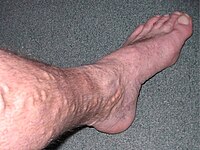
Photo from wikipedia
BACKGROUND Endovenous laser ablation (EVLA) with concomitant phlebectomy is commonly performed in many institutions. However, phlebectomy is associated with cosmetic complications such as surgical scarring, haemorrhage, and hematoma. This study… Click to show full abstract
BACKGROUND Endovenous laser ablation (EVLA) with concomitant phlebectomy is commonly performed in many institutions. However, phlebectomy is associated with cosmetic complications such as surgical scarring, haemorrhage, and hematoma. This study aims to compare the need for additional sclerotherapy during follow-up after EVLA with versus without concomitant phlebectomy. METHODS Between November 2013 and December 2018, we performed EVLA on 1,363 limbs in 1,009 patients with symptomatic primary varicose veins, of which 954 limbs in 771 patients with great saphenous vein (GSV) or small saphenous vein (SSV) insufficiency were included in this study. Data were collected prospectively and supplemented with retrospective medical record review. Demographic and clinical characteristic profiles were collected. The outcomes of EVLA with or without concomitant phlebectomy were compared. Logistic regression was used to assess predictors for additional sclerotherapy after EVLA. RESULTS CEAP classification (P<0.001), operative time (P<0.001), laser device type (P<0.001), length of the treated vein (P<0.001), linear endovenous energy density (P<0.001) and tumescent local anesthesia volume (P<0.001) differed significantly. Pain after EVLA was significantly more frequent in the non-phlebectomy group than in the phlebectomy group (P=0.005). During follow-up, 34 of 954 limbs (3.6%) underwent additional sclerotherapy for residual visible varicose veins after EVLA. No statistical difference was found in the rate of additional sclerotherapy between the groups (P=0.849). Logistic regression showed that female sex (odds ratio [OR], 6.18; 95% confidence interval [CI], 1.86-20.6; P=0.003) is significantly associated with additional sclerotherapy and concomitant phlebectomy is not a significant predictor of additional sclerotherapy (OR, 0.844; 95% CI, 0.375-1.90; P=0.682). CONCLUSION Patient preference for additional sclerotherapy was comparable between those who underwent EVLA with versus without concomitant phlebectomy. This result supports our present strategy of avoiding simultaneous phlebectomy at the time of primary EVLA.
Journal Title: Annals of vascular surgery
Year Published: 2020
Link to full text (if available)
Share on Social Media: Sign Up to like & get
recommendations!